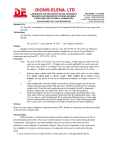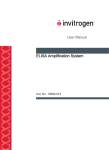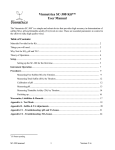Download User manual.
Transcript
Quick test for the determination of L-Lactic acid Intended Use AV-L-Lactic Acid is intended for measuring the L-Lactic Acid level of wine that is undergoing or is about to undergo malolactic fermentation. It can also be used for grape juice and must analysis, including as an indicator of Lactic Acid Bacteria contamination. Methodology AV-L-Lactic Acid is based on the change in color exhibited by a tetrazolium color indicator during a reaction involving L-Lactic acid and nicotine-adenine dinucleotide (NAD) in the presence of the enzyme lactate dehydrogenase. L-LDH L-lactate + NAD pyruvate + NADH Diaphorase NADH + Color Agent (oxidized) NAD + Color Agent (reduced) Sample Samples of grape juice, must and wine may be used as they are. Samples of wines that have undergone malolactic fermentation should be diluted 1:10 prior to analysis if the expected value is greater then 400 mg/L. The ACCUVIN AV-L-Lactic Acid patent pending test strip removes the usual interferences from colored and turbid samples. Samples do not have to be pre-filtered or treated with color removing substances such as activated carbon or polyamide powder. Sample temperature may be from 0°C - 35°C (32°F - 95°F). Procedure 1. 2. 3. Squeeze upper sampler bulb. Dip sampler tip into wine, must or grape juice sample, then release to aspirate sample. (If you prefer to use an air displacement pipette, set sample volume at 20 L.) Transfer sample to the rectangular absorbent layer on back of test strip by squeezing sample bulb. Apply slight pressure with sampler tip. Allow sample droplet to absorb into absorbent layer. Note that only sample present in the sampler tip will be dispensed. Wait 2 min. for color development. Determine sample L-lactic acid level in mg/L by comparing the developed color to the color chart on the test strip container. If test strip color falls between two color chips select an intermediate value for the sample lactic acid level. Note that if a sample was diluted prior to analysis, the sample lactic acid level is 10 times the level obtained from the color chart. (Since fluorescent lights have a green cast, color matching is best under incandescent or natural lighting.) Storage Store away from direct sunlight at temperatures below 80ºF. Keep dry. Product is satisfactory until the date printed on the test strip container label. Summary Interpretation for Most Wines (Because of varietal & stylistic differences, growers & winemakers should make final interpretations.) Malolactic fermentation is a method for reducing total titratable acidity and raising pH by adjusting the relative concentrations of L-malic and L-lactic acids, thus softening the wine and, for a red wine, allowing it to develop the “mellowness and full-bodiedness that are much appreciated elements in quality.” Another benefit of malolactic 2 fermentation is enhanced microbiological stability. In fact, for better control of quality a winemaker usually desires to have the secondary, malolactic fermentation completed as soon after alcoholic fermentation as possible to allow for finishing operations to be completed, and thus to protect stored wine from the jeopardy of harmful microorganisms. Since grapes do not produce lactic acid, monitoring for L(+) lactic acid can be used as an indicator of the onset of malolactic fermentation. Many times laboratories have received samples to check for MLF completion, only to find that MLF has not even started. The winemaker has been misled based on the appearance of bubbling after primary fermentation. The bubbling may not be MLF, but just outgassing of the wine as the barrels warm. Lactic acid, as well as acetic acid, can also be produced prior to and during primary fermentation by contaminating Lactic Acid Bacteria, increasing the risk of stuck fermentation and the presence of off-flavors in the wine. Monitoring grapes/musts for lactic acid levels produced by these contaminating LAB can be used as an indicator of their presence at excessive levels. If found, these microorganisms can be controlled by addition of lysozyme.










